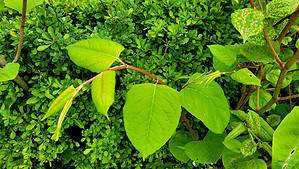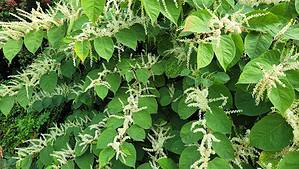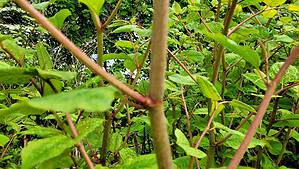What does the Japanese knotweed survey cover?
A Japanese knotweed survey is a thorough assessment conducted by qualified specialists to determine the presence and extent of Japanese knotweed on a property or site. The survey covers various aspects of comprehensively understanding the Japanese knotweed infestation and its potential impact. The primary objectives of a Japanese knotweed survey include:
Identification:
The survey begins by identifying the presence of Japanese knotweed on the property. The specialists will look for the plant’s characteristic features, including its distinctive heart-shaped leaves, bamboo-like stems, and white, frothy flowers.

Japanese Knotweed leaves

Japanese Knotweed in full-flower

Japanese Knotweed stems
Extent of Infestation: The survey aims to determine the size and extent of the Japanese knotweed infestation. Specialists will assess the number of stands, the spread of rhizomes, and the density of the plant on the site.
Site Inspection:
The specialists will inspect the entire property, including buildings, boundaries, gardens, and open areas, to identify any areas affected by Japanese knotweed.
Risk Assessment:
A risk assessment is conducted to evaluate the potential impact of Japanese knotweed on the property, neighbouring areas, and surrounding ecosystems. Factors like proximity to buildings, watercourses, and sensitive habitats are considered.
Rhizome Depth:
The depth and spread of Japanese knotweed rhizomes are crucial in determining the plant’s potential to cause structural damage or re-establish after treatment. The surveyors will assess the depth of the rhizomes based on soil disturbances and growth patterns.
Mapping:
The surveyors will create a map or plan indicating the locations of Japanese knotweed stands and the extent of the infestation. This map can be used for further monitoring and management.
Treatment Recommendations:
The specialists will recommend the most appropriate control and management methods based on the survey findings. These may include herbicide treatment, excavation, or other suitable approaches.
Legal Obligations:
The survey will consider any legal requirements or restrictions related to Japanese knotweed management, including compliance with the Wildlife and Countryside Act 1981.
Report:
After the survey, a comprehensive report summarising the findings, risk assessment, and treatment recommendations is generated. The report is essential for property owners, potential buyers, lenders, and insurers.
A Japanese knotweed survey is a vital first step in developing an effective management plan to control the plant and minimise its impact. Property owners can use the survey findings to make informed decisions about treatment options and implement necessary measures to prevent the spread of Japanese knotweed to neighbouring properties and natural areas.
If the survey says that Knotweed is present, what next?
Suppose the Japanese knotweed survey confirms the presence of Japanese knotweed on your property. In that case, the following steps typically involve developing a comprehensive management plan to control and mitigate the impact of the infestation. Here’s what you can expect to happen next:
Treatment Options:
Based on the survey findings, the specialists will provide you with treatment options tailored to the infestation’s specific characteristics. Standard treatment methods include herbicide application, excavation, burial, or combining these approaches.
Management Plan:
The specialists will develop a detailed management plan that outlines the recommended treatment methods, timing of treatments, and any necessary follow-up actions. The plan will also consider factors such as the size of the infestation, proximity to structures or watercourses, and local environmental regulations.
Legal Obligations:
The management plan will ensure compliance with legal obligations related to Japanese knotweed under the Wildlife and Countryside Act 1981. It will include measures to prevent the intentional spread of the plant to the wild and neighbouring properties.
Cost Estimate:
You will receive a cost estimate for the recommended treatments and the overall management plan. The cost may vary depending on the size of the infestation, the chosen treatment methods, and the complexity of the site.
Treatment Implementation:
The specialists will implement the recommended treatments once you agree to the management plan and cost estimate. Treatment may involve multiple applications over several growing seasons, especially for herbicide-based methods.
Ongoing Monitoring:
After the initial treatments, the specialists will conduct regular monitoring to assess the effectiveness of the control measures and promptly detect any regrowth or new infestations.
Reporting:
Throughout the process, you will receive regular updates and reports on the progress of the treatments and any changes to the management plan based on the site’s conditions.
Post-Treatment Responsibilities:
You will need to follow any post-treatment instructions provided by the specialists, such as restrictions on site disturbance or plant disposal. Responsible disposal of Japanese knotweed waste is crucial to prevent further spread.
Insurance-Backed Guarantee: Some Japanese knotweed removal companies offer insurance-backed guarantees that provide financial cover in case of regrowth during a specified period (e.g., 5 or 10 years) after treatment. You may consider opting for such a guarantee for added peace of mind.
In some cases, It’s essential to address the Japanese knotweed problem promptly and implement the recommended management plan to prevent further spread and potential damage. Engaging qualified invasive species specialists or Japanese knotweed removal companies ensures that the control measures are applied correctly and effectively. With a well-designed management plan and ongoing monitoring, you can successfully manage and control Japanese knotweed on your property.
